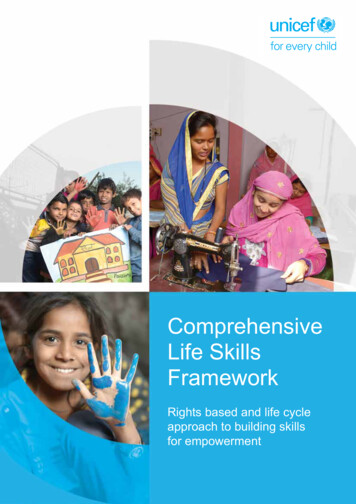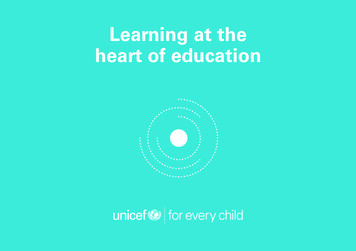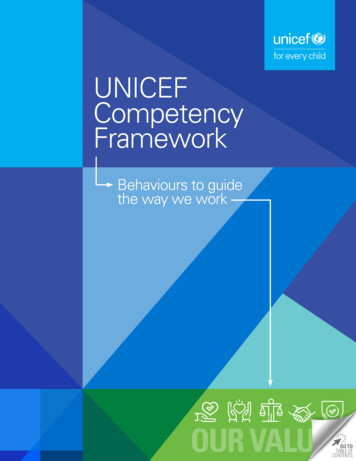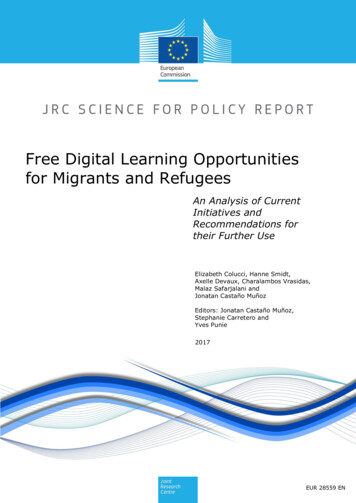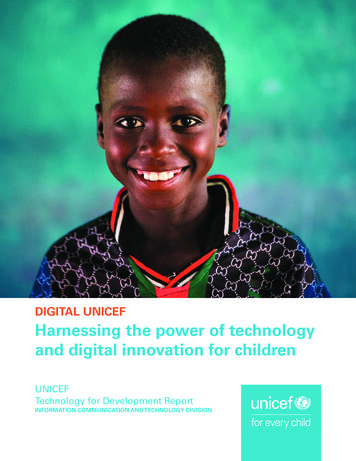
Transcription
DIGITAL UNICEFHarnessing the power of technologyand digital innovation for childrenUNICEFTechnology for Development ReportINFORMATION COMMUNICATION AND TECHNOLOGY DIVISION
Cover image: UNICEF/UN0309435/Mersha/EthiopiaNya Hoth, 18, is taking eighth-grade classes in Tierkidi Refugee Camp, Gambella regional state, Ethiopia.
CONTENTSABBREVIATIONS . .4FOREWORD.5PART 1: EXECUTIVE SUMMARY.8PART 2: ABOUT TECHNOLOGY FOR DEVELOPMENT.11PART 3: ACHIEVEMENTS.17The response to COVID-19.18Digital risk communication and community engagement.18Goal Area 1: Every child survives and thrives.27Goal Area 2: Every child learns.37Goal Area 3: Every child is protected from violence and exploitation.47Goal Area 4: Every child lives in a safe and clean environment.50Goal Area 5: Every child has an equitable chance in life.54Crosscutting.60Big data for strategic insights and decision making.61Frontier technology.62Capacity development.64PART 4: PARTNERSHIPS.65PART 5: PRIORITIES AND THE WAY FORWARD.69FOR MORE INFORMATION.713
ABBREVIATIONSAI Artificial intelligence4COVID-19Coronavirus disease 2019CRVSCivil registration and vital statisticsDHIS2District Health Information Software 2GILGeneration of Innovation LeadersICTDInformation and Communication Technology Division (UNICEF)IoGTInternet of Good ThingsODKOpen Data KitR3DReal-time data-driven dashboardSDGSustainable Development GoalSMSShort message serviceT4DTechnology for DevelopmentUNDPUnited Nations Development ProgrammeUNESCOUnited Nations Educational, Scientific and Cultural OrganizationUNICEFUnited Nations Children’s FundUSAIDUnited States Agency for International DevelopmentWASHWater, sanitation and hygieneWHOWorld Health Organization
FOREWORD5 UNICEF/ UN0442855/Wenga
This past year has been unprecedented in many ways.The coronavirus disease 2019 (COVID-19) pandemicnecessitated that we rethink so much about the way wework at UNICEF – not only to adapt to a remote workplace,but to deliver programmes more efficiently and effectivelyto populations in need in the context of the globalshutdown.For UNICEF’s Information and Communication TechnologyDivision (ICTD), these changes became urgent at a timewhen we were already rethinking how we work. ICTDhas been at the forefront of an organization-wide digitaltransformation designed to build on the exponential growthin digital activities and leverage technology in new ways toachieve results for children.Since its establishment in 2017, the Technology forDevelopment (T4D) function within ICTD, has beendedicated to strengthening health, education, childprotection and other systems to utilize digital technologiesmore effectively. That means building national enablingenvironments for digital transformation; scaling up digitalplatforms; strengthening coordination across platforms andamong partners; and enhancing the viability and maturity ofdigital public goods across the world.UNICEF has learned from this experience that bytransforming ICTD from a back-office help desk functionto one that permeates every aspect of its work, we areable to deliver results for children faster and at scale. Theachievements described in this report reflect that ICTD hasbecome instrumental to how we do business at UNICEF;that our partners in digital technology are propelling thiswork in all areas; and that digital innovations and solutionsare fundamental to improving children’s lives across theworld.As we move towards a new Strategic Plan – in whichfostering UNICEF’s digital maturity will be paramount– this report, which is the companion document to theICTD Annual Report, ‘Digital UNICEF 2020’, provides anopportunity reflect on the remarkable achievements of2020, and the incredible potential of UNICEF’s digitalfuture. UNICEF/UN0410308/TinagoOver the past year, ICTD intensified its collaborationsacross UNICEF and with partners to rapidly develop andexpand programme-centred technologies to meet thecircumstances and needs of the day. We were instrumentalto the organization’s risk communication and communityengagement effort, which leveraged digital technologiesto reach communities with the information they neededto protect themselves against COVID-19. We adaptedUNICEF’s health and education programmes usingreal-time information technology and digital educationsolutions. And we were quick to scale our existingtechnologies for child protection case management, cashtransfers and other systems to ensure that our governmentpartners could continue to reach children in need, despitethe global shutdown.6
UNICEF/UN0351443/TadessePART 1: EXECUTIVE SUMMARY7
1In recent years, UNICEF’s information and communicationtechnology support to digital programming initiatives hasgrown exponentially, shifting from internal managementapproaches to solutions that drive programmeeffectiveness across the globe. With the emergence of theCOVID-19 pandemic in early 2020, UNICEF has acceleratedits transformation into a digital organization – from theupscaling of digital teleworking practices to the use ofinnovative technologies in its programmes, finance andoperations.The pandemic has also brought on a shift in how ournational partners deliver services – from in-person supportto distance and remote delivery – which has made digitaldevelopment integral to how UNICEF works in the field.The rapid acceleration and scale-up of digital programmingand the strategic integration of information andcommunication technologies in national programmes hasallowed UNICEF to help partners close the gaps to meetchildren’s needs in complex environments, in line withexisting national digital ecosystems and solutions.UNICEF ICTD transforms and builds partnershipswith stakeholders to successfully implement UNICEFprogrammes globally through the use of innovative,technology-enabled solutions to achieve better results forchildren. Technology for Development – a core programmefacing function supported by ICTD – supports UNICEF toscale digital programmes, digital innovations and maturedigital solutions and accelerate results for children acrossthe organization.To date, more than 1,400 T4D and innovation initiativeshave been registered in INVENT, UNICEF’s global digitalhub for T4D and innovation. The INVENT platform is bothan inventory of initiatives and a portfolio tool that allowspromising ideas across UNICEF to benefit from greatervisibility. It is helping to focus the organization’s resourcesand investment on the specific programme problems forwhich innovation is an effective change strategy. It servesas a structured and systematic process to identify, validate,select and invest in solutions that are proven to move theneedle forward and generate progress on critical issuesaffecting children.In 2020, UNICEF accelerated its transformation into amodern, digital organization. As part of this strategic shift,UNICEF approved a new Digital Centre of Excellencebased in Nairobi to serve as a dedicated, field-facingglobal structure anchored in ICTD. Among other areas,the Digital Centre of Excellence will support COVID-19vaccine delivery and risk communication and communityengagement through the UNICEF-World HealthOrganization (WHO) COVID-19 Digital Health Centre ofExcellence, which will provide thought leadership, surgecapacity and technical assistance to governments on digitalhealth programmes, in collaboration with developmentpartners.82345Across the organization, and in the context of COVID-19,UNICEF’s digital interventions continued to expand in 2020and drive programme effectiveness across the globe. Aspart of its response to the pandemic, UNICEF reached 3billion people through risk communication and communityengagement initiatives – many of which employed digitalsolutions – to help communities halt the transmissionof COVID-19 and mitigate its socioeconomic impacts.UNICEF deployed chatbots, short message service (SMS),interactive voice response and other technologies throughmultiple channels, including U-Report, RapidPro, Infolines,HealthBuddy, VIAMO Services and Commcare, to reachaffected communities with life-saving information.The rapid expansion of digital programming over the lastyear is also evidenced by the acceleration and uptakeof digital real-time information solutions employed bycountries at scale – a metric that ICTD tracks each year.In 2020, 113 countries (72 per cent) used real-timeinformation technology at scale, exceeding UNICEF’starget of 60 per cent by 2020. This work was carried outacross all Strategic Plan goal areas. Forty-three per cent ofcountry offices reported using RapidPro – a global digitalpublic good used to power messaging programmes – forreal-time information, and 43 per cent of countries alsoreported using platforms such as Kobo, Open Data Kit(ODK), Ona, Commcare and District Health InformationSoftware 2 (DHIS2), among others. More than 40 percent of countries reported using U-Report, powered byRapidPro, for youth/citizen engagement at scale.113countriesused real-timeinformationin 2020UNICEF also worked with national authorities andimplementing partners to adapt service delivery systemsto cope with the socioeconomic impacts of the COVID-19pandemic, limit service interruptions and secure equitableaccess. This effort has raised the profile and value ofdigital health – for delivering life-saving services in theshort term and strengthening national systems, capacitiesand infrastructures over the long term. With informationand communication technology support, countries areleapfrogging into the digital realm where the pandemic hasaccelerated interest and action; further digitizing healthsystems where this process was already underway; andmapping existing digital health solutions with the potentialto support vaccine rollout.
1For example, in Malawi, UNICEF worked with the Ministryof Health and partners such as Good Citizen and BaobonHealth Trust to facilitate safe, remote communicationbetween health workers and those in quarantine andisolation. The COVID-19 quarantine management solutionis a scalable, SMS-based digital platform powered byRapidPro that allows the Ministry of Health to correspondwith those in quarantine, perform real-time trackingof symptoms, and keep everyone safe in line withinfection prevention and control measures. The solution’sinteroperability with other components of Malawi’selectronic disease surveillance system makes informationavailable instantly to authorized users and facilitatesstraightforward data aggregation. As of July, 500 healthcare providers had been registered and nearly 3,900 peoplehad benefited from the programme.UNICEF is also actively engaged in the Access to COVID-19Tools Accelerator as the official coordinator of the COVAXFacility, a global initiative that brings together governmentsand manufacturers to ensure that COVID-19 vaccinesreach those in greatest need. To prepare countries forthis historic vaccine rollout, ICTD and UNICEF Health areparticipating in the COVAX Innovation Working Group andthe COVID-19 Vaccination Delivery Innovation Team. TheTeam is tasked with accelerating the deployment of readilyavailable technical solutions that address coverage, supplychain and safety problems resulting from COVID-19 vaccineintroduction. Its aim: to ensure that countries in need areable to deploy innovative approaches to reaching theirpopulations with vaccines, at scale.UNICEF has led international efforts to bring virtual andother forms of remote learning to children across theworld. This has involved collaborating with partners toprovide online and distance learning to millions of outof-school children, and helping children return to schoolvia remote means using information and communicationtechnologies. UNICEF is also supporting schoolconnectivity, education technology strategies, and needsassessment, planning and deployment. With the launchof the Reimagine Education initiative, UNICEF is seekingto connect every child and young person with world-classdigital solutions that offer personalized learning.UNICEF also took steps in 2020 to close the learning gapin the context of COVID-19. In partnership with Microsoft,UNICEF expanded the Learning Passport, a global digitallearning platform to help children and youth affected byCOVID-19 continue their education at home. By the endof the year, Learning Passport had been deployed in morethan a dozen countries. For example, in Timor-Leste,Learning Passport is giving some 400,000 students onlineaccess to their national school curriculum.UNICEF is also using technology and digital innovationto strengthen child protection information managementsystems – including civil registration and vital statisticssystems, monitoring and reporting on violations againstchildren, and case management. This work is not only2345generating reliable and timey data on child protection, butalso connecting children with the protection services theyneed. In December, UNICEF, in partnership with Microsoft,launched Primero X, a newly designed and highly scalableprogressive web application that can meet the demands ofthe social welfare sector – in the context of COVID-19 andbeyond.2.8 millionhouseholds receivedcash assistance in YemenIn Cambodia, UNICEF supported the Ministry of SocialAffairs, Veterans and Youth Rehabilitation to launch Primeroduring the COVID-19 pandemic. The platform was adaptedto act as a secure bridge between government caseworkers and existing service providers, enabling disparatesystems to “talk to each other”. Today, children can benefitfrom safe and secure referrals between government andlocal non-governmental organizations, faster responsetimes and more organizational accountability. In thecontext of COVID-19, this interoperability has meant bettercoordination and fewer children falling through the cracks.Between April and November 2020, 150 Cambodian caseworkers became active Primero users and 5,500 childrenwere reached.UNICEF also used digital technologies to vastly expandits cash transfer programmes in 2020 to reach familiesimpacted by the socioeconomic effects of COVID-19.During the year, UNICEF implemented technology-enabledcash transfer solutions in 30 country offices. In Yemenalone, UNICEF reached 2.8 million households – including8.4 million children – using digital and other technologysolutions.In Jordan, UNICEF supported the Government to expandthe existing cash transfer programme to 200,000 dailywage workers who had lost their income due to theCOVID-19 response; and adapt the programme toadhere to infection prevention and control measures.Using RapidPro, UNICEF helped the Government reachnew recipients quickly, remotely, and safely via mobilewallets, at no cost to beneficiaries. The results exceededexpectations. In the first five days of implementation, thenumber of targeted daily workers with an active mobilewallet increased from 18,000 to 80,000. After two weeks,188,000 workers had an active mobile wallet and hadreceived cash transfers.UNICEF is increasingly working to identify technologicalsolutions and innovations that address challenges andcreate new opportunities for UNICEF programming. Thiscan include real-time monitoring and predictive analysis,digital identity, artificial intelligence (AI)/deep learning, anddigital innovations. Innovations in real-time data collectionand visualization, complemented by big-data analytics9
1and AI, provide safe, rapid and comprehensive alternativeapproaches to in-person assessments. UNICEF/UN0419385/DejonghFor example, in Indonesia, where the COVID-19 pandemicis threatening to undermine recent development gains,UNICEF supported the Government’s COVID-19 responsethrough a range of cutting-edge data platforms andpartnerships, including monitoring dashboards thatempower community members to monitor and reportpublic adherence to COVID-19 safety protocols; schoolconnectivity data, which yield insights into the distributionof digital opportunities among Indonesian students; andCOVID-19 immunization dashboards, which leverageexisting datasets and real-time monitoring to enablebeneficiary registration, feedback and coverage analyses.102345The achievements for children described above andthroughout this report were made possible by thethousands of people across UNICEF and its partnerorganizations who have contributed to and supportedthe application of T4D. Looking ahead towards UNICEF’snext Strategic Plan, the organization will capitalize on themomentum of 2020 and set the stage for a reimaginedUNICEF: one that is agile, digital and modernized, andwhere the innovative use of technology cuts across itswork. UNICEF’s new digital strategy will focus on furtherexpanding digital interventions in health, education, socialand child protection, environment and water, sanitationand hygiene (WASH) to strengthen government systems,advance progress towards the Sustainable DevelopmentGoals (SDGs), and accelerate the delivery of results forchildren.
UNICEF/UNI322149/ Frank DejonghPART 2: ABOUT TECHNOLOGY FORDEVELOPMENT11
1UNICEF recognizes the vital role of information andcommunication technology in enabling innovationand digital programming. ICTD transforms and buildspartnerships with stakeholders to successfully implementUNICEF programmes globally through the use ofinnovative, technology-enabled solutions to achieve betterresults for children. T4D – a core programme functionsupported by ICTD – provides advisory, implementationand quality assurance services to programmes on the useof technology and digital innovation in UNICEF-supportedprogramming.Within UNICEF’s Innovation for Results cone, ICTD issituated alongside the Office of Innovation, the SupplyDivision, the Office of Global Insight and Policy and theOffice of Research. The T4D function works in closecollaboration with multisectoral programme and planningteams and national partners in support of national goalsand sectoral priorities, the UNICEF Strategic Plan 2018–2021 and the SDGs.234ICTD recognizes that innovative solutions – includingdigital solutions – are useful only when they add value,accelerate service delivery, and expand reach and resultsfor children; and scale is reached when the innovation,digital programming approach or solution is owned and ledby a national government. While ICTD staff provide adviceand guidance to national partners on the use of digitalinnovation and frontier technologies, the vast majority ofUNICEF’s digital programming work – and UNICEF’s digitalinitiatives– involves the use and deployment of proven,mature digital solutions and digital public goods designedto strengthen national systems, in line with national needsand capacities.Digital transformation enables UNICEF to increasingly enable, deliver and mainstream digitalprogramming, services and innovations by augmenting new staff functions and capacities, integratingsoftware/hardware (e.g., software as service and cloud computing), enabling automation and increasingagility, while transforming national programmes.T4D enables and is enabled by UNICEF’s digital transformation. As the use of technology becomesintegrated across UNICEF programmes, the organization will need to ensure that these effortsstrengthen national systems, result in tangible benefits to children, can be sustained without donorfunds, and prioritize data security and child safeguarding. This often requires engaging on national policyand regulatory reform; collaborating with ministries of information and communication technology,eGovernment and communications authorities; providing technical guidance to ministries of health,education, etc. on their digital systems architecture, infrastructure, data management and informationexchanges; providing technical assistance on digitally-enabled programmes, including readinessassessments, business requirements, platform assessments, investment cases, deployment and scalingand end-user testing; and building strategic partnerships and consortia, including with the private sector.125
12345Box: UNICEF’s Digital Transformation: Unpacking how ICTD supports UNICEFprogrammesWe take scalable innovations and technology solutions and deliver them, directly impacting the lives of millionsof children around the globe, each year.We enable technology and digital innovation in the field at scale, through our strong collaboration withprogramme teams, in-country technical advice, support to national partners, and engagement with UnitedNations agencies and other partners on technology and digital public goods. We serve as a unique resource,facilitator and a connector across programmes, planning and operations.We help identify the most promising technologies and digital innovations for application across the globe, andsupport UNICEF programmes to adopt, adapt and scale up the approaches that are most useful, and to quicklyidentify those that are not.We institutionalize and mainstream technologies and digital innovations that show promise, in support ofnational goals and priorities, UNICEF’s Strategic Plan and the SDGs.We support country deployment and testing of frontier technologies to make sure that solutions are designedand implemented with the best chance for scale and national ownership.We help country offices develop and promote innovation and information and communication technologystrategies that align with national governments’ long-term development needs through dedicated strategicplanning.And we continuously build UNICEF and programme partners’ capacities for T4D and innovation governancedigital public goods.ICTD: What we doFor UNICEF, technology, innovation and digitalprogramming are the collective responsibility of the entireorganization. To this end, UNICEF has reimagined itsculture of information and communication technology asa digital programming and transformation function thatpromotes innovative behaviours across the organizationand leverages digital approaches to accelerate results forchildren.For ICTD, that means serving as a resource, facilitatorand connector that supports innovation across theorganization, rather than on behalf of it. It meansstrengthening capacities for T4D and innovation amongUNICEF staff and national partners; and providing countryoffices with the guidance they need to implement T4D anddigital programmes based on evidence, good practices andexperience.Key to this process is providing technical assistance toT4D and innovation work across country and regionaloffices to enhance efficiencies, effectiveness, alignment,coherence and governance. That means working in closecollaboration with UNICEF programme and planningfunctions – including through technical expertise, advisoryservices and programme guidance – to design and supportevidence-based programme-facing T4D and innovativeinitiatives.In countries, ICTD staff work with programme and planningteams across UNICEF to strengthen national systemsand deploy new digital approaches to programming. Wehelp scale up well-established and proven products andinnovative approaches and tools, including digital publicgoods. That includes supporting knowledge management,learning and the exchange of experiences; and enablingSouth-South and North-South dialogue, research andreports on challenges and best practices.13
1Partnerships are essential to everything we do. Ourpartnerships with the public, private and academic sectorsdrive UNICEF programming enabled by T4D and innovation.We also leverage the comparative advantages, experiencesand resources of other United Nations agencies, donorsand partners through joint planning, coordination,programming and experience sharing of T4D and digitalinitiatives to achieve results for children.3451,400T4D and innovationinitiatives documentedin INVENTINVENT: Powering innovation and technologyfor development for childrenThe Business Relationship Management andTechnology PlaybookInnovation and T4D boost and bolster the impact ofUNICEF’s work to ensure that every child survives andthrives. As we strive to respond, support recovery and helpcommunities build back better from the unprecedentedCOVID-19 pandemic, innovation and T4D hold the promiseof life-changing breakthroughs.In the Roadmap for Digital Cooperation launched in 2020,United Nations Secretary-General António Guterres citedthe need to achieve universal connectivity and promotedigital public goods to foster a sustainable and inclusiverecovery from the COVID-19 pandemic. Digital capacitybuilding is central to this initiative. The World Bankestimates that up to 87 per cent of large public sectorinformation and communication technology projectsfail due to lack of regulations, guidelines, management,context and skills.To meet our global aims, UNICEF is launching bold,exciting new initiatives to tap into and channel ourcollective creative energy and invest in proven,scalable solutions. INVENT is UNICEF’s global digital hubfor T4D and innovation. It expands on a process born inthe field – an inventory of T4D and innovation initiativesdeveloped by T4D and innovation focal points at theregional and country office levels over the past three years.INVENT is both an inventory of initiatives and a portfoliotool that allows promising ideas across UNICEF to benefitfrom greater visibility and alignment with resources tobring them to scale. The platform serves as a sharedglobal resource for innovation and T4D initiatives. Througha structured process guided by regional T4D managers,UNICEF country offices add their innovation and T4Dinitiatives of all types – data, digital, frugal, innovativefinance, physical product and programming innovations – toa searchable global inventory.The portal also serves to better focus the organization’sresources and investment on the specific programmeproblems for which innovation is an effective changestrategy. The approach is a structured and systematicprocess to identify, validate, select and invest in solutionsthat are proven to move the needle forward and generateprogress on critical issues affecting children.To date, more than 1,400 T4D and innovation initiativeshave been included in the inventory.142Having documented over 1,400 T4D and innovationinitiatives across over 125 countries globally, ICTDis focused on developing standard processes forimplementing T4D projects in the field. This meansestablishing strategic, scalable, and sustainable approachesto guiding and streamlining digital transformation acrossthe organization’s programmes.In 2020, the UNICEF East Asia and the Pacific informationand communication technology team began developing aglobal Business Relationship Management and TechnologyPlaybook, a standard framework for helping programmeteams integrate T4D and digital innovations that embodythe Principles of Digital Development into programmedesign, implementation and monitoring and evaluation. Itwill be used to ensure that technology is leveraged at everystep in a way that is context-appropriate and sustainable.
12345Box: Spotlight on the Business Relationship Management and Technology PlaybookTechnology can be used as a tool to increase local capacity, transparency, stakeholder engagement and reachfor UNICEF projects. Having a standard process for T4D field implementation at the project level will span theproject lifecycle phases while embodying the Principles for Digital Development. This will help UNICEF build andsustain the capacity to operate, maintain, support, adapt and improve the technology over the project’s lifecycle.The following three factors are critical to programmatic success:1. The area of intervention;2. The degree of engagement with the state institutions, contextual factors such as local capacity andthe buy-in from all stakeholders;3. Programmatic design and management.An agile, incremental approach to designing, developing, testing and refining a T4D solution goes a long waytowards producing platforms that meet the needs of the users and are, therefore, embraced by them.ICTD Digital Centre of ExcellenceICTD is leading UNICEF’s digital transformation throughits support for digitally-enabled programmes, digital publicgoods, digital partnerships, frontier technology and digitalinnovation. Given the focus on digital transformation underUNICEF’s new 2022-2025 Strategic Plan, ICTD is revisingits structures and the capacities of its staff to be more fitfor purpose.In 2020, UNICEF approved a ne
UNICEF is also using technology and digital innovation to strengthen child protection information management systems - including civil registration and vital statistics systems, monitoring and reporting on violations against children, and case management. This work is not only generating reliable and timey data on child protection, but





